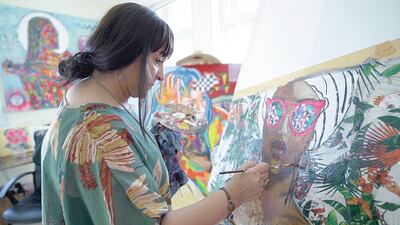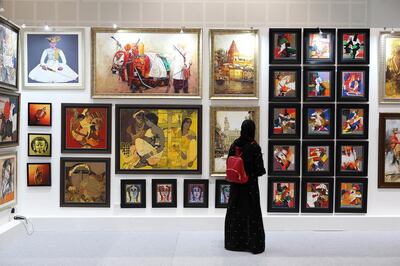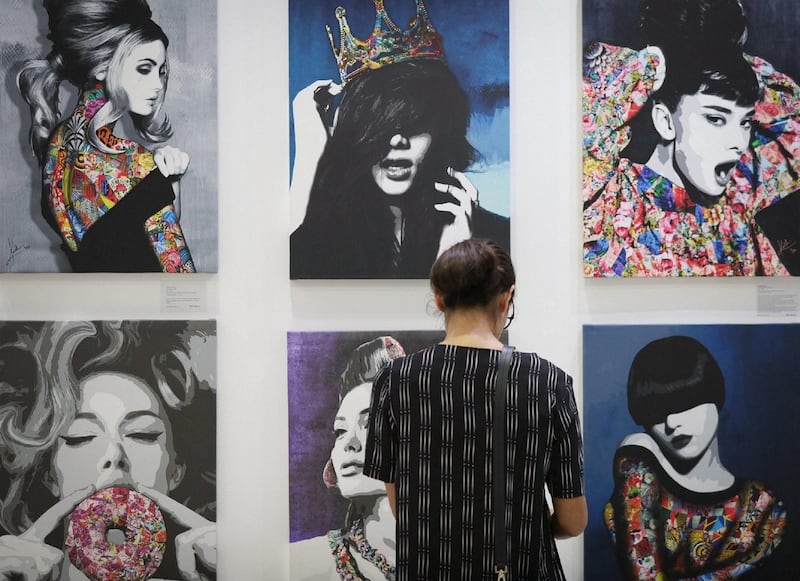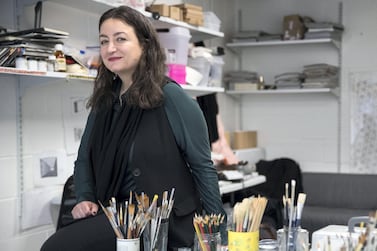I was chatting to a gallerist at an art fair recently, and asked about a small, brightly coloured drawing by a mid-career artist. “It’s attractively priced at 10,000,” he said.
“Dirhams?”
“Dollars.”
For anyone who’s ever thought of buying a piece of artwork, and then actually enquired about the prices at an art fair, the experience is dispiriting at best. The contemporary art market has long since soared out of reach for most of the buying public, even those with discretionary income to spend.
Fortunately a number of satellite fairs have popped up in various cities to offer artworks that many people can reasonably afford. Dubai’s affordable fair starts today, in its fifth year: World Art Dubai, at the Dubai World Trade Centre.
Over 150 galleries are participating, both local and international — such as the Indian gallery Aart SouqK 6 or the UK gallery Ben Eine & Pure Evil, which sells pop-inspired graffiti work. A smattering of stalls are leased by artists to show their own work, such as Islamic-inspired abstractions by the Saudi artist Abeer Abdullah Al-Khalifah, paintings by the Cairo-born Wageeh Hassan, and a mix of figurative and abstract paintings by the Syrian artist Abdelrahman Shamieh, which are priced at around $500 (Dh1840) to $1000. Luis Fuentes, a Peruvian artist, has a stall of paintings of house windows framing the sea for around $1000 to $5000.
The fair also has events for the public, some done in collaboration with the Repton School, one of the fair’s many sponsors. Unlike higher end fairs, which demand large amounts for booth rentals, World Art Dubai relies more on sponsors, which ends up giving the fair a more community feel.
A graffiti workshop runs from 4pm to 6pm every day of the fair, and events for children include making yarn-toys on Thursday from 3 to 4 and abstract painting from 3pm to 4.30pm on Saturday.
There are talks too: highlights are a talk about street art’s transformation from illegal urban activity to luxury item by Louis Lee Wright, the owner of Ben Eine & Pure Evil, on Friday, April 5, at 6.30pm. Rachael Brown, who runs the Dubai-based art consultancy Capsule Arts, lectures on the emerging arts scene in the UAE on Saturday April 6, at 5.30pm.
The fair aims to be democratic in other ways as well. It gives two prizes for best artists, for example: one selected by curators, who receives free exhibition space for next year’s World Art Dubai edition, and a second art winner voted for by World Art Dubai visitors themselves.
Finally, the fair boasts its Wall of Art, in which each piece is $100 (yes, dollars). Not a scary price at all, and it will last longer than a Dubai brunch.

Eight tips for new collectors
If you are heading to World Art Dubai to start a collection, here are some tips on how to begin:
1. If you like something, ask the gallerist to explain it to you.
Get to know as much about the work as you can, why they started making it and how they started making it, and of how it fits into an artists’ career overall. Art is a springboard for stories.
2. Street art is a great (and popular) entryway into the art world, particularly because its style and price point are more accessible to emerging collectors.
But because of the distinctiveness of the style, make sure that you understand how each artist differs from the others. You might end up wanting to go with someone whose work is off the beaten track, and can become more interesting to follow in the long term.

3. People often say not to think of art as an investment, but that's not true — it’s just a variable investment, and there’s absolutely no guarantee that the piece of artwork you buy will be one to go up.
Still, if the idea of parting with the price of a family holiday for a painting scares you, remember that there is a potential for resale value.
No one likes to talk about this, because no one wants collectors to flip an artwork. And if you give any indication that you are buying it just to make money, no dealer worth his or her salt will sell to you. But if you’re making a large purchase, it’s worth sussing out whether the dealer works with the artist regularly, what shows he or she has coming up, and their general level of ambition.
If the dealer represents an artist, that’s good news — it means they’re committed to acting as an agent for the artist, placing his or her work with museums, giving them a solo show around every two years, and helping liaise with curators to get their work in major shows. A dealer will usually take 50 per cent of the sale of an artwork.
One caveat, however, about the context of a fair such as World Art Dubai. Affordable fairs have reasonably priced art works precisely because many of their exhibiting galleries do not operate in the established art-world system, so you’re often spending less money but are foregoing the security of the apparatus around the artist’s future work.
4. Think about editions.
This is often a cheaper way to be able to own an established artists’ work, and unless you are thinking about returns on investment, it doesn’t really matter in the end if your work is unique or not. If it does matter, don’t buy in an edition higher than 10.
5. Think about what the artwork will look like in five or ten years.
In the UAE’s sunlight you need to be especially careful about where you hang the work. Works on paper and collages can fade badly, so keep them somewhere that doesn’t get a lot of light. For this same reason, painting lasts well — and there is the added frisson of knowing that the artist’s own hand executed the work.
6. Don’t be afraid of unusual shapes and sizes!
A great thing about living in the UAE is that you can get all sorts of plinths and frames made at very low cost. And there is really nothing grander than calling to enquire after the progress of one’s plinth.
7. Ask to be put in touch with the artist, if you are making a big purchase and he or she is not there.
Artists can feel a real sense of loss when they spend time making a work and don’t know where it ends up. The relationship between a collector and an artist is an unusual one — a mix of admiration, gratitude, some consternation on both sides — and developing it is an unexpected add-on to buying an artwork by a living artist, especially if they are young.
8. It’s a cliche, but only buy it if you love it.
You want it to be able to hold your attention and give new things back to you every time you look at it. And if you feel like it’s going to surprise you again and again, almost like a human being would, then it’s worth inviting into your home.
World Art Dubai takes place until April 6 at Dubai World Trade Centre. Tickets are Dh10 for those aged 10 to 18, and general admission for Dh25. www.worldartdubai.com







